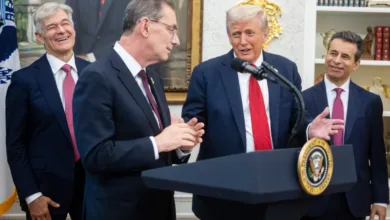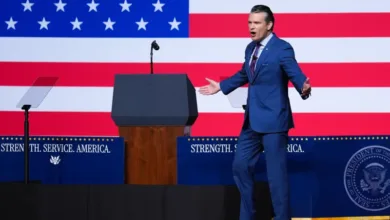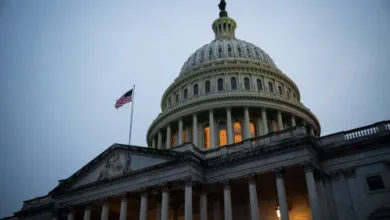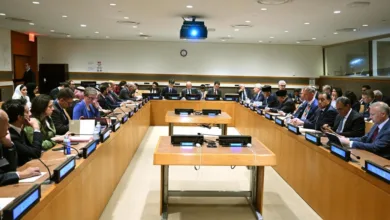Why Trump’s Map Played a Decisive Role in His Vision of the Ukraine War
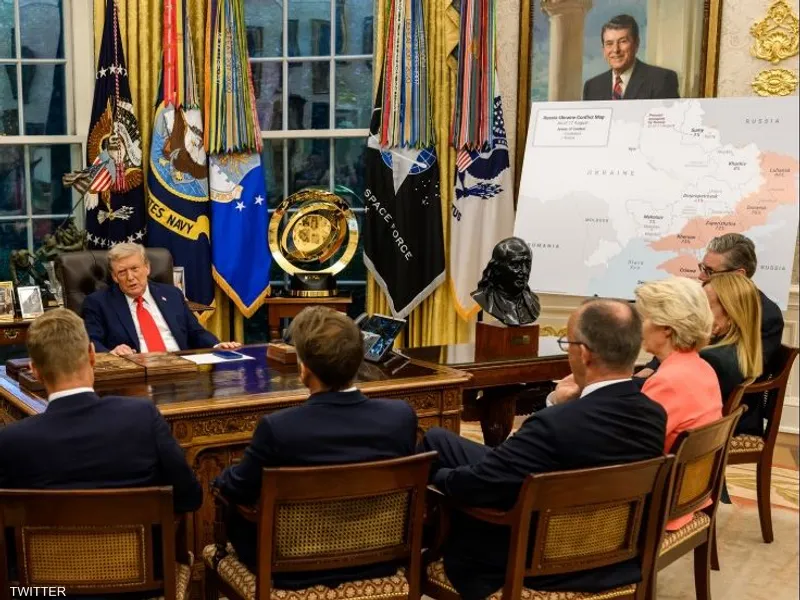
During his recent meeting with Ukrainian President Volodymyr Zelensky at the White House, former President Donald Trump presented a large map of Ukraine highlighting territories currently under Russian control. The visual display was meant to underscore the scale of Russia’s territorial gains and set the tone for discussions about potential territorial concessions.
Speaking to Fox News on Tuesday, Trump remarked: “I assume you all saw the map. A large portion of land has been taken. These are the territories that have been seized.”
The map, marked in red to indicate areas controlled by Moscow, quickly became a focal point of political debate. It suggested that the White House message to Kyiv was clear: vast territories may be lost, and it could be time to consider territorial negotiations with Russian President Vladimir Putin.
This approach has sparked controversy across the U.S. and Europe, dominating headlines in Breaking News and reshaping global discussions about the future of the conflict.
The Symbolism of Trump’s Map
A Visual Argument
By placing the map front and center, Trump emphasized a hardline reality: Russia currently occupies nearly 20% of Ukrainian territory. The shaded red areas, stretching across Donbas, Zaporizhzhia, Kherson, and beyond, were not just data points but a visual negotiation tool.
The Message to Zelensky
According to Zelensky, his team brought their own maps to counter Trump’s presentation, arguing over “who controls what — not rumors, but actual realities.” Still, Trump remained firm in his belief that Russia’s grip had become “much stronger” and was unlikely to weaken anytime soon.
Conflicting Perspectives
Kyiv’s Stand
Zelensky has consistently resisted suggestions of territorial concessions, framing them as a betrayal of Ukraine’s sovereignty. During the meeting, he disputed the percentages shown on Trump’s map, pointing out that Ukraine still controls roughly 6,600 square kilometers of the Donbas despite Russia’s advances.
Washington’s Interpretation
For Trump and his advisors, the map served as evidence that Russia’s control was extensive and consolidating. The implication: negotiations should reflect this “new reality.” Critics argue that such framing risks legitimizing Russia’s aggression and undermines Ukraine’s long-term security.
The Numbers Behind the Map
Control in Donbas
The White House map displayed figures such as:
-
99% of Luhansk under Russian control.
-
76% of Donetsk controlled by Moscow.
-
73% of Zaporizhzhia and Kherson occupied in the southeast.
-
Smaller footholds in Kharkiv, Sumy, and Mykolaiv regions.
Analysts at the U.S.-based Institute for the Study of War (ISW) confirmed that the numbers broadly align with their own estimates, though slight discrepancies remain due to methodological differences in measuring control.
Russian Ambitions
Despite Russia’s annexation claims over four regions plus Crimea, large swaths remain contested. Experts warn that capturing all of Donetsk could take Russia years, requiring multiple costly military campaigns.
Moscow’s Reaction
Zakharova’s “Slap in the Face” Comment
Russian Foreign Ministry spokesperson Maria Zakharova mocked the display, describing the map as a “slap in the face” to Kyiv. Speaking on Sputnik Radio, she claimed the visual exposed “how much Ukraine and its supporters have lost, in every sense of the word.”
Her remarks echoed Kremlin narratives that Ukraine’s resistance is futile and that Western support is detached from “geographic and historical realities.”
European Dilemmas
Allies Torn Over Concessions
Within Europe, Trump’s framing reignited debates about the feasibility of territorial swaps as a step toward ending the war. While some leaders view it as pragmatic, others fear it rewards aggression and sets a dangerous precedent for future conflicts.
A Test for NATO Unity
The controversy also puts NATO under strain. As members debate long-term commitments to Kyiv, Trump’s map reinforces divisions between those advocating for negotiations and those demanding a complete restoration of Ukraine’s borders. Coverage in World highlights these ongoing tensions.
The Road Ahead
Ukraine’s Difficult Choices
Zelensky continues to reject any settlement that cedes territory, insisting that Ukraine’s sovereignty is non-negotiable. However, with Russia entrenched in large parts of the east and south, Ukraine faces increasingly difficult military and diplomatic decisions.
Trump’s Calculated Move
For Trump, the map is more than a visual aid; it is a political weapon. By framing the war as one of unavoidable territorial losses, he positions himself as a realist in contrast to what he portrays as Western idealism. This narrative will likely play a central role in future U.S. debates about foreign policy and military aid, particularly as it feeds into U.S News coverage.
Trump’s use of a territorial control map during talks with Zelensky was more than symbolic—it was a deliberate attempt to redefine the terms of the Ukraine war debate. While Kyiv disputes the figures and insists on full sovereignty, the map has already reshaped international conversations about concessions, negotiations, and the balance of power in Eastern Europe.
Whether it becomes a lasting symbol of pragmatism or a dangerous precedent for appeasement remains to be seen. What is certain is that Trump’s map has become a new battlefield—one fought not with weapons, but with perceptions, narratives, and political strategy.
